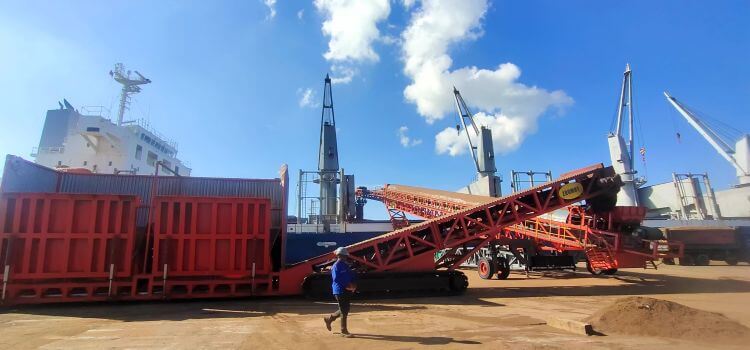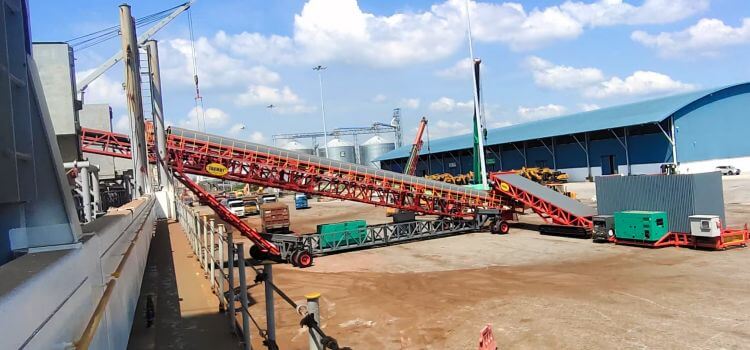In global trade and resource transportation, the efficiency of bulk material handling at ports directly impacts supply chain costs and turnaround speed. Traditional fixed equipment often suffers from rigid layouts and limited flexibility, struggling to cope with diverse vessel types, constrained space, and fluctuating cargo throughput. Zoomry Heavy Industry (Zoomry), leveraging its deep expertise in bulk material handling equipment, has innovatively integrated wheeled/crawler truck unloaders with fully hydraulic mobile shiploaders to provide global port operators with an efficient, flexible, and intelligent material handling solution.

I. Pain Points in Port Bulk Handling and Collaborative Solutions
Key Challenges
- Space constraints: Narrow operational areas in aging terminals or inland ports hinder deployment of large fixed equipment.
- Vessel diversity: Handling vessels ranging from barges to Capesize bulk carriers requires shiploaders with wide height adjustment (e.g., 8m–16m) and precise pitch positioning.
- Unloading bottleneck: Long truck queues, inefficient manual unloading, and high costs create logistics bottlenecks.
- Poor material flow coordination: Remote or poorly designed unloading/loading points force reliance on secondary truck transfers, increasing costs and pollution.
- Environmental pressure: Open operations generate dust and noise, demanding sealed conveying systems and dust suppression.
Collaborative Solution
- Efficiency leap: Truck unloaders (e.g., ZRLD-TU1800) achieve 1,800 TPH throughput, while mobile shiploaders (e.g., ZRSL-60) serve Capesize vessels, forming a closed "unload-convey-load" loop.
- Space optimization: Mobile units require no fixed foundations, enabling flexible relocation to maximize limited dock space. Crawler truck unloaders operate seamlessly on rough terrain.
- Smart connectivity: Truck unloader discharge chutes directly feed mobile shiploader hoppers (10m³+) or use portable grasshopper/jump conveyors for short-distance transfers, eliminating secondary trucking.
- Multifunctionality: Mobile shiploaders double as radial stackers for yard storage during non-loading periods.
- Green intelligence: PLC automation, enclosed conveyors (e.g., tubular options), PU cleaners, and dust chutes significantly reduce emissions and noise.

II. Technical Breakdown of Key Equipment
Truck Unloader
Replacing manual or excavator unloading, truck unloaders allow dump trucks to ascend a ramp and discharge bulk materials (ore, coal, grain, aggregates) into a hopper for rapid conveyor transfer.
Technical Highlights
Example: Zoomry ZRLD-TU1800 Crawler Truck Unloader
- Adaptability: Crawler undercarriage handles muddy or uneven terrain.
- High-capacity hopper: Low-profile, wide-opening design (up to 5.7m width) accommodates heavy trucks at a 6.7° incline (12.1% slope).
- Efficient conveying: 1,800mm belt width, 1,800 TPH capacity with adjustable speed.
- Smart control: Full-function remote control enables safe operator monitoring of ramp elevation and conveyor operation.
- Hydraulic stability: Outriggers ensure steadiness; hydraulics drive ramp movement.
- Custom screening: Adjustable grids prevent oversized material blockages.
Mobile Shiploader
Zoomry’s mobile shiploaders integrate travel, rotation, pitch, and telescoping to accurately load bulk materials from upstream systems into vessel holds.
Technical Highlights
Example: Zoomry ZRSL Series
- Universal compatibility: Modular ZRSL-40 to ZRSL-60 models serve barges to Capesize ships with 0–16m+ height adjustment.
- Radial telescoping boom: Hydraulic winch extends inner conveyor (10–22m), working with rotation for full coverage, minimizing vessel shifts.
- Hydraulic power: 500–650L reservoir ensures smooth pitch/telescope motions.
- Safety redundancy: Dual rope-break protection (mechanical + hydraulic lock, 0.01s response), belt sway switches, emergency pull cords.
- Automation: PLC auto-loading system with HMI presets vessel profiles, automating travel, rotation, and material flow for precision.
- Clean operation: PU primary/secondary cleaners + empty-belt scrapers maintain hygiene.
- Power options: Diesel genset or shore power for off-grid use.
III. Collaborative Workflow
High-Speed Truck Unloading
- Ore-laden dump trucks ascend the crawler truck unloader’s (ZRLD-TU1800) hydraulic ramp.
- Operators remotely control ramp elevation for hopper discharge.
- Bottom conveyor (1,800mm width) transfers material at 1,800 TPH.
Flexible Material Transfer (Optional)
For distant unloading points, crawler grasshopper conveyors (e.g., ZR120D) bridge gaps to shiploader hoppers with adjustable discharge heights.
Precision Loading Operation by Mobile Shiploader
- The mobile shiploader (ZRSL-50, compatible with Handymax/Panamax vessels) autonomously moves to the designated berth via its crawler system.
- Operators select the target vessel type and preset program from the control room or HMI touchscreen.
- The PLC system precisely coordinates the shiploader's core operations: positioning the entire machine at the optimal starting point; rotating the boom to accurately align with the target cargo hold; intelligently adjusting the boom's pitch angle based on real-time tidal changes and vessel draft to achieve ideal loading height; and finally extending the internal conveyor to position it directly above the hatch opening for material reception.
- Ore from the truck unloader (or grasshopper conveyor) enters the shiploader's receiving hopper and is precisely discharged into the cargo hold via the boom conveyor. The PLC system automatically controls boom extension/retraction, rotation, and trolley movement based on material accumulation patterns, ensuring even distribution throughout the hold to maximize capacity utilization while preventing uneven loading.
- Upon completing one hold, the shiploader either moves autonomously or rotates its boom to proceed with loading operations in the next hold.
Synergy Benefits
- Efficiency: Matched unloader/shiploader capacities eliminate bottlenecks.
- Zero retransfer: Direct conveyor transfer cuts trucking costs, tire wear, and emissions.
- Flexibility: Rapid reconfiguration for varying berths or cargo types.
- Labor savings: Remote/PLC automation reduces onsite staff and risks.
IV. Why Choose Zoomry’s Collaborative Solution?
With 20+ years in bulk handling, Zoomry’s edge lies in:
- End-to-end R&D: Self-developed truck unloaders, mobile shiploaders, stackers, and components (idlers, pulleys, cleaners) ensure compatibility and longevity (e.g., idlers: ≤2N rotation resistance, 50,000h lifespan).
- Engineering mastery: EPC experience in complex terrains (steep slopes, crossings, tunnels) informs port-optimized designs.
- Smart integration: PLC automation, HMI interfaces, and wireless controls enable precision and visibility.
- Certified quality: ISO 9001/14001, CE, EAC, KCS certifications; critical parts (e.g., 40Cr-forged pulley shafts ≥200mm, ultrasonically tested) meet global standards.
- Global support: Lifecycle services from design to maintenance.
The synergy between truck unloaders and mobile shiploaders epitomizes modern port bulk handling’s shift toward efficiency, flexibility, intelligence, and sustainability. Zoomry’s technology-driven collaboration model empowers ports to overcome spatial limits, streamline operations, and boost competitiveness in an era prioritizing supply chain resilience and eco-efficiency.

 ZOOMRY
ZOOMRY

